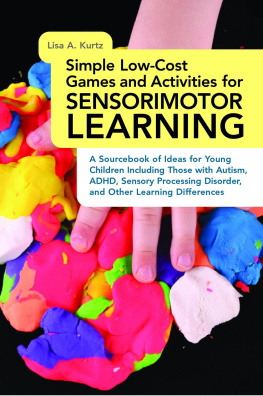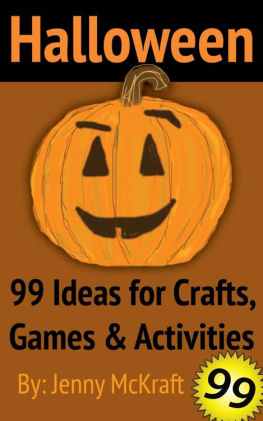Also from Meadowbrook Press Busy BooksThe Toddlers Busy Book, The Preschoolers Busy Book, The Arts & Crafts Busy Book , and The Wiggle Giggle Busy Book each contains 365 activities (one for each day of the year) for your children using items found around the home. The books offer parents and child-care providers fun reading, math, and science activities that will stimulate a childs natural curiosity. They also provide great activities for indoor play during even the longest stretches of bad weather! Both show you how to save money by making your own paints, play dough, craft clays, glue, paste, and other arts-and-crafts supplies.
Busy BooksThe Toddlers Busy Book, The Preschoolers Busy Book, The Arts & Crafts Busy Book , and The Wiggle Giggle Busy Book each contains 365 activities (one for each day of the year) for your children using items found around the home. The books offer parents and child-care providers fun reading, math, and science activities that will stimulate a childs natural curiosity. They also provide great activities for indoor play during even the longest stretches of bad weather! Both show you how to save money by making your own paints, play dough, craft clays, glue, paste, and other arts-and-crafts supplies.  Feed Me! Im Yours Parents love this easy-to-use, economical guide to making baby food at home. More than 200 recipes cover everything a parent needs to know about teething foods, nutritious snacks, and quick, pleasing lunches.
Feed Me! Im Yours Parents love this easy-to-use, economical guide to making baby food at home. More than 200 recipes cover everything a parent needs to know about teething foods, nutritious snacks, and quick, pleasing lunches.  Play and LearnBaby Play and Learn and Preschooler Play and Learn, from child-development expert Penny Warner, offer ideas for games and activities that will provide hours of developmental learning opportunities and fun for young children and babies.
Play and LearnBaby Play and Learn and Preschooler Play and Learn, from child-development expert Penny Warner, offer ideas for games and activities that will provide hours of developmental learning opportunities and fun for young children and babies.
Each book contains bulleted lists of skills your child will learn through play activities, step-by-step instructions, and illustrations.  Discipline without Shouting or Spanking This book is the most practical discipline guide available and will assist parents with the most difficult part of parenting. It provides proven methods for handling over 30 of the most common forms of childhood misbehaviors, from temper tantrums to sibling rivalry.
Discipline without Shouting or Spanking This book is the most practical discipline guide available and will assist parents with the most difficult part of parenting. It provides proven methods for handling over 30 of the most common forms of childhood misbehaviors, from temper tantrums to sibling rivalry.  Mary Had a Little Jam With over three quarters of a million copies sold, this is the #1 fractured nursery rhymes book in North America. Its a delightful way to introduce young children to Jack & Jill, Humpty Dumpty, and all the rest of Mother Gooses characters.
Mary Had a Little Jam With over three quarters of a million copies sold, this is the #1 fractured nursery rhymes book in North America. Its a delightful way to introduce young children to Jack & Jill, Humpty Dumpty, and all the rest of Mother Gooses characters.  Peter, Peter, Pizza-Eater This book contains 40 silly rhymes guaranteed to put smiles on the faces of preschoolers and early-elementary kids.
Peter, Peter, Pizza-Eater This book contains 40 silly rhymes guaranteed to put smiles on the faces of preschoolers and early-elementary kids.
Each rhyme recounts the adventures of a well-loved Mother Goose characterwith a funny twist. Stephen Carpenters full-color illustrations make this amusing book even more entertaining. We offer many more titles written to delight, inform, and entertain:www.meadowbrookpress.com
ANIMAL PARTS
Have your child match the heads and tails of various animals. Or, let her have fun making crazy new animals!
| Learning Skills: | Body image Classification skills Cognitive/thinking skills Fine motor development |
Materials:
Pictures of animals from magazines or inexpensive picture books Scissors Glue or paste Sheets of construction paper Floor or table
What to Do:
Cut out pictures of various animals. Cut the pictures in half, separating the head area from the tail area. Place the head halves on the floor or table in front of your child.
Pull out one of the tail halves and let her match it to the appropriate head. Have her glue each completed animal onto a sheet of construction paper. Repeat until all the animals are reconnected. Variation: Have your child intentionally mismatch the heads and tails to create funny new animals! Caution: Put away the scissors after you cut up the pictures, and make sure your child doesnt put glue in her mouth. 
ANIMAL WALK
Your child will have fun walking just like the animals! Help him use his imagination to move his arms, legs, head, and body.
| Learning Skills: | Classification skills Dramatic play Emotional expression Gross motor development Social skills |
Materials:
Large room Picture books that include animals with distinct walks such as ducks, crabs, frogs, kangaroos, elephants, inchworms, chickens, rabbits, seals, snakes, caterpillars, and so on
What to Do:
Leaf through various picture books about animals.
As you read, encourage your child to try to walk like the animals in the books. Help him by describing the movements and demonstrating if necessary. For example, show him how the duck waddles, the crab moves sideways, the kangaroo leaps, the elephant lumbers, the inchworm inches, the chicken lunges, the rabbit hops, the seal slides, the snake slithers, and the caterpillardoes a caterpillar walk! Variation: Take turns imitating an animal walk and have the other person guess what animal you are! Caution: Make sure the area is clear of obstacles. 
BACK WORDS
Your childs language skills are exploding, so encourage her to have fun with words by giving them a new twist. Say sentences and phrases backwards!
| Learning Skills: | Cognitive/thinking skills Emotional expression Language and vocabulary development Sequencing Social interaction |
Materials:
Mealtime setting
What to Do:
Play during mealtime, so your child can learn the game while using familiar sentences. Start with simple sentences like More milk please and Thank you.
Say them backwards: Please milk more and You thank. Demonstrate a few times so she understands how to play. Progress to longer sentences as your child gets better at playing the game. Variation: Have a backwards hour when you do and say everything backwards. Or, try acting out a scene from a favorite book together backwards! Caution: If your child becomes frustrated because she cant understand the game, try using two-word sentences only, or stop and try again a few days later. 
BOX CAR
A simple box can turn a child into a creative genius who can learn to do wonderful things with his mind and body!
| Learning Skills: | Body awareness Creativity and imagination Fine and gross motor development Spatial relationships |
Materials:
Large box about half the size of your child Scissors or X-acto knife Duct tape Felt-tip pens, crayons, paint, stickers, decals, fringe, and other decorative materials Book about cars and trucks
What to Do:
Read a book about cars and trucks together and study the pictures.
Cut the top and bottom off a large box, leaving the sides intact. Use duct tape to cover any rough edges and to reinforce corners, if needed. Help your child decorate the outside of the box to look like a car or truck using felt-tip pens, paint, stickers, and so on. When the car is finished, let your child take a drive around the house or yard. For added fun, set up roads by laying down rope as a guide, and set up stop signs along the route. 







 Busy BooksThe Toddlers Busy Book, The Preschoolers Busy Book, The Arts & Crafts Busy Book , and The Wiggle Giggle Busy Book each contains 365 activities (one for each day of the year) for your children using items found around the home. The books offer parents and child-care providers fun reading, math, and science activities that will stimulate a childs natural curiosity. They also provide great activities for indoor play during even the longest stretches of bad weather! Both show you how to save money by making your own paints, play dough, craft clays, glue, paste, and other arts-and-crafts supplies.
Busy BooksThe Toddlers Busy Book, The Preschoolers Busy Book, The Arts & Crafts Busy Book , and The Wiggle Giggle Busy Book each contains 365 activities (one for each day of the year) for your children using items found around the home. The books offer parents and child-care providers fun reading, math, and science activities that will stimulate a childs natural curiosity. They also provide great activities for indoor play during even the longest stretches of bad weather! Both show you how to save money by making your own paints, play dough, craft clays, glue, paste, and other arts-and-crafts supplies. 



